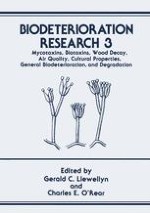1990 | OriginalPaper | Buchkapitel
Coriolus versicolor, A Model System to Investigate the Biotechnology of Wood-Deteriorating Enzymes
verfasst von : Ann C. Williams, Nina L. Moore, William V. Dashek, Arthur L. Williams
Erschienen in: Biodeterioration Research
Verlag: Springer US
Enthalten in: Professional Book Archive
Aktivieren Sie unsere intelligente Suche, um passende Fachinhalte oder Patente zu finden.
Wählen Sie Textabschnitte aus um mit Künstlicher Intelligenz passenden Patente zu finden. powered by
Markieren Sie Textabschnitte, um KI-gestützt weitere passende Inhalte zu finden. powered by
Coriolus versicolor, a white-rot basidiomycete, elaborates cellulolytic and ligninolytic enzymes both in situ and in vitro (Evans and Palmer, 1983; Taylor et al., 1987, 1988; Moore et al., 1989). These enzymes can degrade cellulose (Peterson et al., 1963) and lignin (Harvey et al., 1987), the main polymers of wood (Higuchi, 1985). Besides its presence within wood, lignocellulose often constitutes an unwanted component in the paper-pulp industry and also renders certain agricultural commodities less digestible to ruminants (Dodson et al., 1986; Van der Meer et al., 1987). Thus, an available supply of ligno-cellulolytic enzymes could be of marked industrial value. To maintain an adequate supply, substrate induction coupled to hyphal ‘batch culture’ (Fahraeus and Reinhammer, 1967) and/or genetic engineering techniques (Maniatis et al., 1982; Bennett and Lasure, 1985; Current Protocols in Molecular Biology, 1987) are being sought to over-produce these enzymes. Here are reported pertinent recombinant DNA techniques (Williams et al., 1988, 1989a, b) which may result in enhanced enzyme synthesis by Escherichia coli transformants harboring the C. versicolor gene(s) for polyphenol oxidase (PPO), an enzyme relevant to lignin degradation (Kirk and Kelman, 1965) as well as converting the purported disease-resistance, phenolic compounds (Taylor et al., 1989) to diquinones (Fric, 1976).
